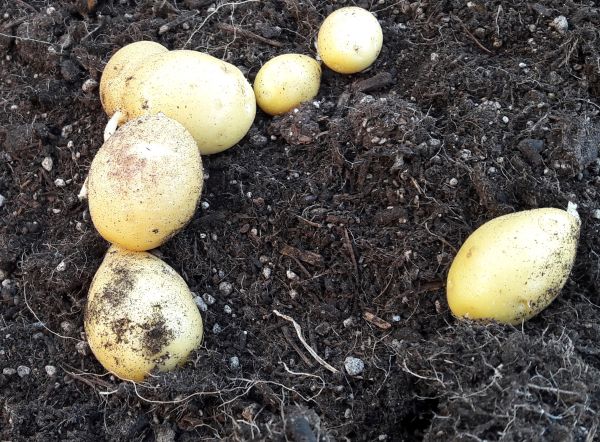
Maybe you’ve heard of nematodes – those beneficial worms that kill many a garden pest. Or are you thinking more about parasites that can harm your plants or even affect your health?
In this article you will learn about this still rather unknown group of animals and how you can protect yourself from them or use them specifically to combat annoying pests.
Contents
What are nematodes and how can you use them?
Nematodes are tiny, elongated worms and are therefore also called threadworms. They are (almost) invisible to the naked eye, and some species can only be seen under a microscope.
There are many different species of nematodes. They are either free-living or parasites – meaning they need a host to feed on.
This host can be plants, animals, or even us humans. Each nematode species very specifically attacks one or very few hosts. So nematodes that infest plants cannot harm us humans. Similarly, those that attack animal pests are harmless to us.
Nematodes as plant pests
Nematodes that harm our plants are also called elders. They live in the soil and require high soil moisture. From there, they infest the roots, stems or leaves of their victims, depending on the species. They penetrate the plants through injuries or stomata and suck out the cells. Infested plant parts turn brown or even die, subsequently increasing susceptibility to fungal diseases.
In the garden, the greatest damage is caused to ornamental plants, e.g. phlox, daffodils and hyacinths by cane or stem lice, and to asters, anemones, violets, zinnias, begonias or various sedum species by leaf lice. Strawberries (leaves) or edible onions (bulbs) may also be affected.
Root nematodes, as the name suggests, penetrate the roots and fine root hairs of their host plants and suck out the sap there directly. Sometimes they even form so-called cysts on the roots – the cysts contain nematode eggs that can survive protected for long periods of time. The nematode offspring hatch only when conditions are favorable.

Prevention and control:
Mixed cropping and wide crop rotation – prevents accumulation of a nematode species.
Disposal of infested plants – diseased plants are best disposed of in the residual waste garbage can. Do not put them in the compost under any circumstances.
Grow fine plants – marigolds (marigolds) and marigolds are effective against root nematodes. The ingredients kill the aphids as soon as they suck on the roots.
Nematodes as beneficial or enemy of nuisance animals in the garden.
There are some pests in the garden or even in the house that you can effectively control with nematodes.
Nematodes against the weevil
The thick-mouthed weevil (or broad-mouthed weevil) is a nocturnal beetle belonging to the weevil family. It is now very widespread and can be found in almost every garden.
Damage pattern: the beetle eats bay-shaped notches in leaves of cherry laurel, hydrangea, privet and other perennials and woody plants.
Even more dangerous, however, is the white, thick-fleshed larva that nibbles on the roots and can cause the plants to die.
Nematodes are available against both the adult beetle and its larvae. The best time to use nematodes against the larvae is from mid-April to early June and from September to mid-October.
You can find a detailed description of the pest, possibilities of confusion and control in the article “Biological control of the pine weevil”.
The control of the larvae should be done regularly, i.e. 1 x in spring and 1 x in autumn. Unfortunately, new beetles migrate again and again, so you have to “keep at it” consistently.
Nematodes against fungus gnat larvae
Fungus gnats are small, black gnats (like mini flies) that often appear by the hundreds and thousands after repotting houseplants or filling a raised bed with fresh soil. You bought the fungus gnat larvae with the soil – they feel very comfortable in the flower pot and multiply rapidly.
In the article Annoying fungus gnats – and what you can do against them, you will learn how to recognize these animals, what damage they do to your plants and how you can get rid of the gnat army again.
There are also nematodes that are specifically effective against fungus gnat larvae. The treatment is possible all year round. As with all nematodes, it is important to keep the soil well moist and to be patient. Because it takes a few days until the effect of the beneficial insects becomes visible and noticeable.
Nematodes against meadow snails and mole crickets
Yellow-brown spots in the lawn? Parts of your lawn are dying? This doesn’t have to be a fungal infestation or drought damage. A circular infestation in the spring indicates meadow snake larvae. These feed on the roots of the grass and are responsible for small and larger bare patches.
Autumn, from mid-September after egg laying, is the best time to control meadow snails with nematodes.
The mole cricket is a representative of the order of grasshoppers – but unlike the well-known grasshoppers, it lives underground. It causes damage through the tunnels it digs about 10 cm below the surface of the soil, nibbling on the roots of all plants standing in its way.
Use nematodes against mole crickets from the end of April to the end of May. In the greenhouse already from March.

